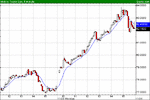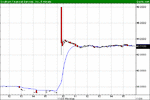clylbw
Well-known member
- Messages
- 454
- Likes
- 4
Hi,
As you may have all been aware, some US shares tend to gap up or down pre and during the beginning of trading, especially those in the news.
However, it seems to me that there are 'good' and 'bad' gapping shares. The 'good' ones jump in the beginning, and keep upping until towards the end of the session, an example being today's MBT.
'Good' gapping stock like the above is what I have been looking for. But there seems to be another group of gapping stocks, the 'bad' ones. These gap up or down at the opening, and then just stay there for the rest of the session, as today's SFFB showed.
Since some of my best trades are from 'good' gapping shares and some of my worst ones from the second group, I wonder whether there are some ways to tell them apart. Market scanners do not seem to work in this aspect... 🙁
Thanks a lot indeed.
As you may have all been aware, some US shares tend to gap up or down pre and during the beginning of trading, especially those in the news.
However, it seems to me that there are 'good' and 'bad' gapping shares. The 'good' ones jump in the beginning, and keep upping until towards the end of the session, an example being today's MBT.
'Good' gapping stock like the above is what I have been looking for. But there seems to be another group of gapping stocks, the 'bad' ones. These gap up or down at the opening, and then just stay there for the rest of the session, as today's SFFB showed.
Since some of my best trades are from 'good' gapping shares and some of my worst ones from the second group, I wonder whether there are some ways to tell them apart. Market scanners do not seem to work in this aspect... 🙁
Thanks a lot indeed.


